Tags
Crown Prince Wilhelm of Germany and Prussia, Duchess Cecilie Auguste Marie of Mecklenburg-Schwerin, German Crown Princess and Crown Princess of Prussia, German Emperor Wilhelm II, Grand Duchess Anastasia Mikhailovna of Russia, Grand Duke Friedrich Franz III of Mecklenburg-Schwerin, King Christian X of Denmark, Princess Alexandrine of Mecklenburg-Schwerin, Princess Charlotte of Prussia
Duchess Cecilie Auguste Marie of Mecklenburg-Schwerin (September 20, 1886 – May 6, 1954) was the last German Crown Princess and Crown Princess of Prussia as the wife of Wilhelm, German Crown Prince, the son of German Emperor Wilhelm II.
Cecilie was a daughter of Grand Duke Friedrich Franz III of Mecklenburg-Schwerin and Grand Duchess Anastasia Mikhailovna of Russia.
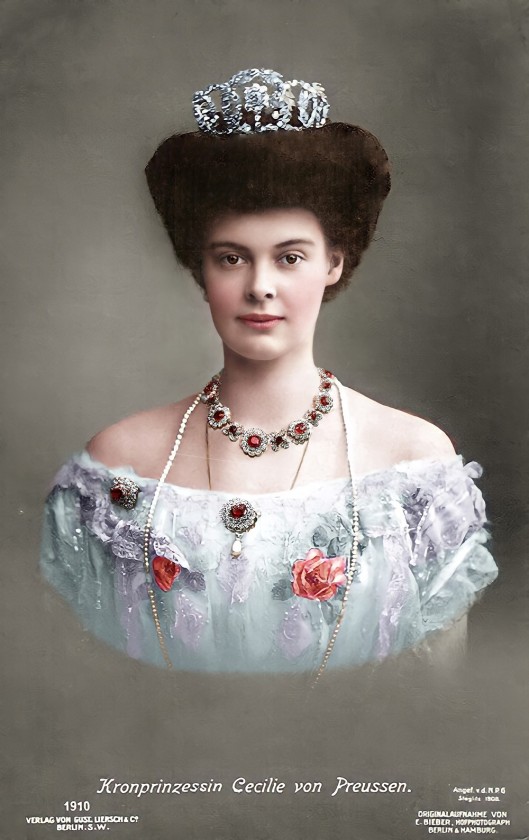
Grand Duchess Anastasia Mikhailovna of Russia was the daughter of Grand Duke Michael Nikolaevich of Russia was the fourth son and seventh child of Emperor Nicholas I of Russia and Charlotte of Prussia.
On August 16, 1857, Grand Duke Michael Nikolaevich of Russia married Princess Cecilie of Baden (1839–1891), daughter of Leopold, Grand Duke of Baden and Sophie of Sweden.
Grand Duke Friedrich Franz III of Mecklenburg-Schwerin was the son of Grand Duke Friedrich Franz II of Mecklenburg-Schwerin, and his first wife Princess Augusta Reuss of Köstritz.
Cecilie of Mecklenburg-Schwerin and her husband, Crown Prince Wilhelm of Germany and Prussia were cousins. Both were descendants of Friedrich Wilhelm III, King of Prussia, and Duchess Louise of Mecklenburg-Strelitz (from a collateral branch of the Mecklenburg Royal House).
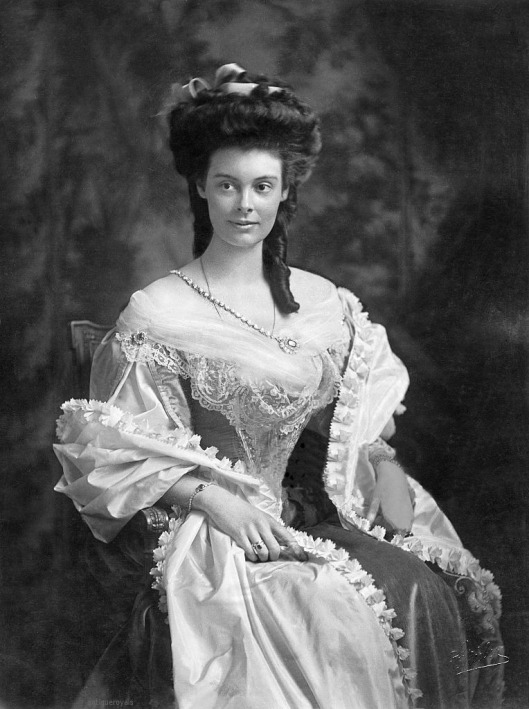
Cecilie was a granddaughter of Charlotte of Prussia the eldest surviving daughter and fourth child of Friedrich Wilhelm III, King of Prussia, while her husband was a great-grandson of Charlotte’s brother, Wilhelm I, German Emperor and King of Prussia.
She was brought up with simplicity. and her early life was peripatetic, spending summers in Mecklenburg and the rest of the year in the south of France. After the death of her father, she traveled every summer between 1898 and 1904 to her mother’s native Russia.
She spent most of her childhood in Schwerin, at the royal residences of Ludwigslust Palace and the Gelbensande hunting lodge, only a few kilometres from the Baltic Sea coast. Her father suffered badly from asthma and the wet damp cold climate of Mecklenburg was not good for his health.
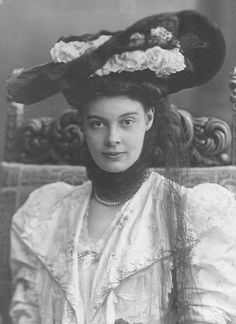
As a result, Cecilie spent a large amount of time with her family in Cannes in the south of France, favoured at the time by European royalty, including some whom Cecilie met such as Empress Eugénie and her future husband’s great-uncle, Edward VII.
During the winter visit of 1897, Cecilie’s sister, Alexandrine, met her future husband, Crown Prince Christian, later Christian X of Denmark, shortly before the death of their father at the age of 46. After returning to Schwerin, Cecilie spent time with her widowed mother in Denmark.
The wedding of her sister took place in Cannes in April 1898. After the death of her father, she traveled every summer, from 1898 to 1904, visiting her relatives in Russia. Cecilie lived there in Mikhailovskoe on Kronstadt Bay, the country home of her maternal grandfather, Grand Duke Michael Nikolaevich of Russia.
Engagement
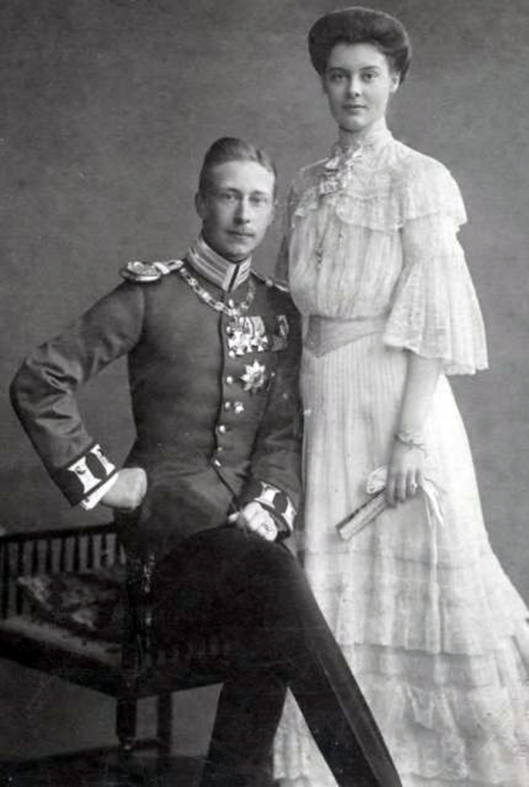
Duchess Cecilie of Mecklenburg-Schwerin and the Wilhelm, Crown Prince of Germany in 1905.
During the wedding festivities of her brother Grand Duke Friedrich Franz IV of Mecklenburg-Schwerin in Schwerin in June 1904, the 17-year-old Duchess Cecilie got to know her future husband, Wilhelm, German Crown Prince.
German Emperor Wilhelm II had sent his eldest son to the festivities as his personal representative. Taller than most women of her time at 182 centimetres (over 5’11”), Cecilie was as tall as the German Crown Prince. Wilhelm was struck by her great beauty, and her dark hair and eyes.
On September 4, 1904, the young couple celebrated their engagement at the Mecklenburg-Schwerin hunting lodge, Gelbensande. The Emperor as an engagement present had a wooden residence built nearby for the couple. On September 5, the first official photos of the couple were taken.
Wedding
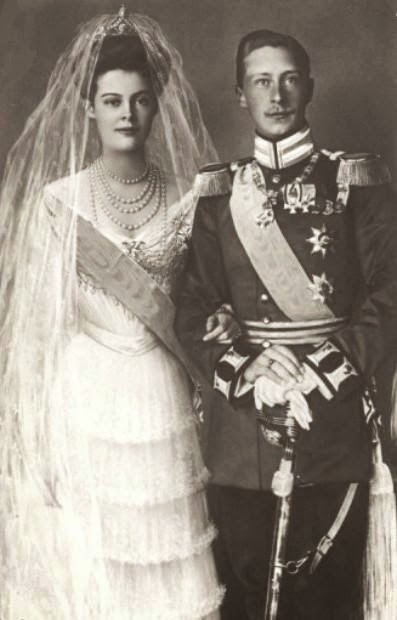
The wedding of Duchess Cecilie of Mecklenburg-Schwerin and the German Crown Prince Wilhelm took place on June 6, 1905 in Berlin. Arriving from Schwerin at Berlin’s Lehrter Station, the future Crown Princess was greeted on the platform with a gift of dark red roses.
She was greeted at Bellevue Palace by the entire German Imperial Family and later made a joyeuse entrée through the Brandenburg Gate to a gun salute in the Tiergarten. Crowds lined the sides of the Unter den Linden as she passed on the way to the Berlin Royal Palace.
Emperor Wilhelm II greeted her at the palace and conducted her to the Knight’s Hall where over fifty guests from different European royal houses awaited the young bride including Grand Duke Michael Alexandrovich of Russia, Archduke Franz Ferdinand of Austria as well as representatives from Denmark, Italy, Belgium, Portugal and the Netherlands. On her wedding day, Emperor Wilhelm II presented his daughter-in-law with the Order of Louise.
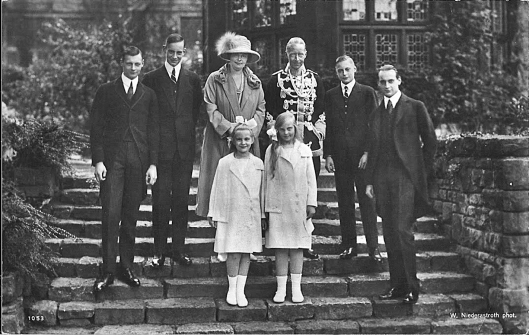
The wedding ceremony took place in the Royal Chapel and also the nearby Berlin Cathedral. The royal couple received as wedding presents jewellery, silverware and porcelain. At the wish of the bride, Richard Wagner’s famous wedding march from Lohengrin was played along with music from The Meistersinger from Nuremberg conducted by Richard Strauss.
On her wedding day, Duchess Cecilie of Mecklenburg-Schwerin became Her Imperial and Royal Highness The German Crown Princess and Crown Princess of Prussia. She was expected to one day become German Empress and Queen of Prussia.
German Crown Princess
As German Crown Princess, Cecilie quickly became one of the most beloved members of the German Imperial House. She was known for her elegance and fashion consciousness. It was not long before her fashion style was copied by many women throughout the German Empire.
However, her husband was a womanizer and the marriage was unhappy.
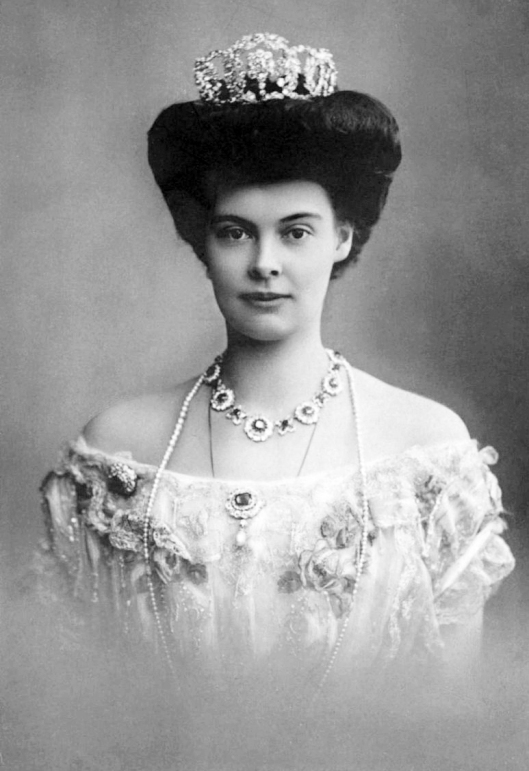
After the fall of the German monarchy, at the end of World War I, Cecilie and her husband lived mostly apart. During the Weimar Republic and the Nazi period, Cecilie lived a private life mainly at Cecilienhof Palace in Potsdam.
With the advance of the Soviet troops, she left the Cecilienhof in February 1945, never to return. She settled in Bad Kissingen until 1952 when she moved to an apartment in the Frauenkopf district of Stuttgart. In 1952, she published a book of memoirs. She died two years later, on May 6, 1954, which would have been her husband’s 72nd birthday.
